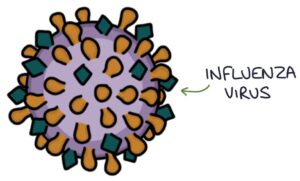The influenza virus is an RNA virus. Three types of influenza, A, B and C, affect humans (a D type affects cattle). A and B are the most common. Type A has different H and N subtypes. Examples of A strains are H1N1 (which caused the Spanish flu pandemic of 1918 and the swine flu pandemic of 2009) and H5N1 (which causes bird flu). Outbreaks of flu typically occur during the winter.

Vaccination
Every year the influenza vaccine is altered to target multiple strains that are circulating that year. Yearly vaccines are required.
The flu vaccine is free on the NHS to people at higher risk of developing flu or flu-related complications:
- Aged 65 and over
- Young children
- Pregnant women
- Chronic health conditions, such as asthma, COPD, heart failure and diabetes
- Healthcare workers and carers
Presentation
The delay between exposure and symptoms is usually around 2 days. Typical presenting features include:
- Fever
- Lethargy and fatigue
- Anorexia (loss of appetite)
- Muscle and joint aches
- Headache
- Dry cough
- Sore throat
- Coryzal symptoms
TOM TIP: There is a lot of overlap between the common cold and flu, but some key features can help you differentiate them clinically. Flu tends to have an abrupt onset, whereas a common cold has a more gradual onset. Fever is a typical feature of the flu but is rare with a common cold. Finally, people with the flu are “wiped out” with muscle aches and lethargy, whereas people with a cold can usually continue many activities.
Testing
Testing may be considered to confirm the diagnosis and monitor circulation and outbreaks. The UK Health Security Agency (UKHSA) monitors the number of flu cases and provides guidance when the numbers are high.
Point-of-care tests using swabs are available, giving a rapid result. They detect viral antigens. They are not as sensitive as formal lab tests and do not give information about the subtype of the virus.
Viral nasal or throat swabs can be sent to the local virology lab for polymerase chain reaction (PCR) analysis. This can confirm the diagnosis and help with tracking case numbers and patterns.
Management
Healthy patients who are not at risk of complications do not need treatment. The infection will resolve with self-care measures, such as adequate fluid intake and rest.
There are two options for treatment in someone at risk of complications of influenza:
- Oral oseltamivir (twice daily for 5 days)
- Inhaled zanamivir (twice daily for 5 days)
Treatment needs to be started within 48 hours of the onset of symptoms to be effective.
Post-exposure prophylaxis may be given where patients meet specific criteria:
- It is started within 48 hours of close contact with influenza
- Increased risk (e.g., chronic disease or immunosuppression)
- Not protected by vaccination (e.g., it has been less than 14 days since they were vaccinated)
Options for post-exposure prophylaxis are:
- Oral oseltamivir 75mg once daily for 10 days
- Inhaled zanamivir 10mg once daily for 10 days
Complications
- Otitis media, sinusitis and bronchitis
- Viral pneumonia
- Secondary bacteria pneumonia
- Worsening chronic health conditions, such as COPD and heart failure
- Febrile convulsions (young children)
- Encephalitis
Last updated July 2023
Now, head over to members.zerotofinals.com and test your knowledge of this content. Testing yourself helps identify what you missed and strengthens your understanding and retention.

